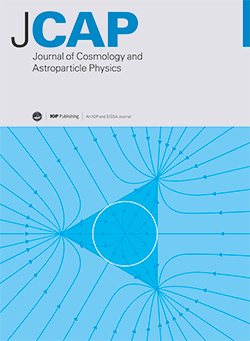Fréchet vectors as sensitive tools for blind tests of CMB anomalies
IF 5.3
2区 物理与天体物理
Q1 ASTRONOMY & ASTROPHYSICS
Journal of Cosmology and Astroparticle Physics
Pub Date : 2025-06-18
DOI:10.1088/1475-7516/2025/06/039
引用次数: 0
Abstract
Cosmological data collected on a sphere, such as CMB anisotropies, are typically represented by the spherical harmonic coefficients, denoted as aℓm. The angular power spectrum, or Cℓ, serves as the fundamental estimator of the variance in this data. Alternatively, spherical data and their variance can also be characterized using Multipole Vectors (MVs) and the Fréchet variance. The vectors that minimize this variance, known as Fréchet Vectors (FVs), define the center of mass of points on a compact space, and are excellent indicators of statistical correlations between different multipoles. We demonstrate this using both simulations and real data. Through simulations, we show that FVs enable a blind detection and reconstruction of the location associated with a mock Cold Spot anomaly introduced in an otherwise isotropic sky. Applying these tools to the 2018 Planck maps, we implement several improvements on previous null tests of Gaussianity and statistical isotropy, down to arc-minute scales. Planck's MVs appear consistent with these hypotheses at scales 2 ≤ ℓ ≤ 1500 when the common mask is applied, whereas the same test using the FVs rejects them with significances between 5.3 and 8.2σ. The inclusion of anisotropic noise simulations render the FVs marginally consistent (≥ 2σ) with the null hypotheses at the same scales, but still rejects them at 3.5-3.7σ when we consider scales above ℓ=1500, where the signal-to-noise is small. Limitations of the noise and/or foregrounds modeling may account for these deviations from the null hypothesis.作为CMB异常盲测的敏感工具的fracimet向量
在一个球体上收集的宇宙学数据,如宇宙微波背景的各向异性,通常用球面调和系数表示,表示为一个lm。角功率谱,或C,作为该数据中方差的基本估计量。另外,球面数据及其方差也可以使用多极矢量(Multipole Vectors, mv)和fracimchet方差来表征。将这种差异最小化的向量,称为fracimchet vectors (FVs),定义紧致空间上点的质心,是不同多极之间统计相关性的优秀指标。我们使用模拟和真实数据来证明这一点。通过模拟,我们表明fv能够盲检测和重建与在其他各向同性天空中引入的模拟冷斑异常相关的位置。将这些工具应用于2018年的普朗克地图,我们对之前的高斯性和统计各向同性的零测试进行了几项改进,直至弧分尺度。当使用普通掩模时,普朗克的mv在2≤r≤1500的尺度上与这些假设一致,而使用fv的相同测试在5.3和8.2σ之间显著性地拒绝了它们。各向异性噪声模拟使得fv在相同尺度下与原假设基本一致(≥2σ),但当我们考虑大于1500的尺度时,信噪比较小,fv在3.5-3.7σ时仍然与原假设不一致。噪声和/或前景建模的局限性可以解释这些与原假设的偏差。
本文章由计算机程序翻译,如有差异,请以英文原文为准。
求助全文
约1分钟内获得全文
求助全文
来源期刊

Journal of Cosmology and Astroparticle Physics
地学天文-天文与天体物理
CiteScore
10.20
自引率
23.40%
发文量
632
审稿时长
1 months
期刊介绍:
Journal of Cosmology and Astroparticle Physics (JCAP) encompasses theoretical, observational and experimental areas as well as computation and simulation. The journal covers the latest developments in the theory of all fundamental interactions and their cosmological implications (e.g. M-theory and cosmology, brane cosmology). JCAP''s coverage also includes topics such as formation, dynamics and clustering of galaxies, pre-galactic star formation, x-ray astronomy, radio astronomy, gravitational lensing, active galactic nuclei, intergalactic and interstellar matter.
 求助内容:
求助内容: 应助结果提醒方式:
应助结果提醒方式:


